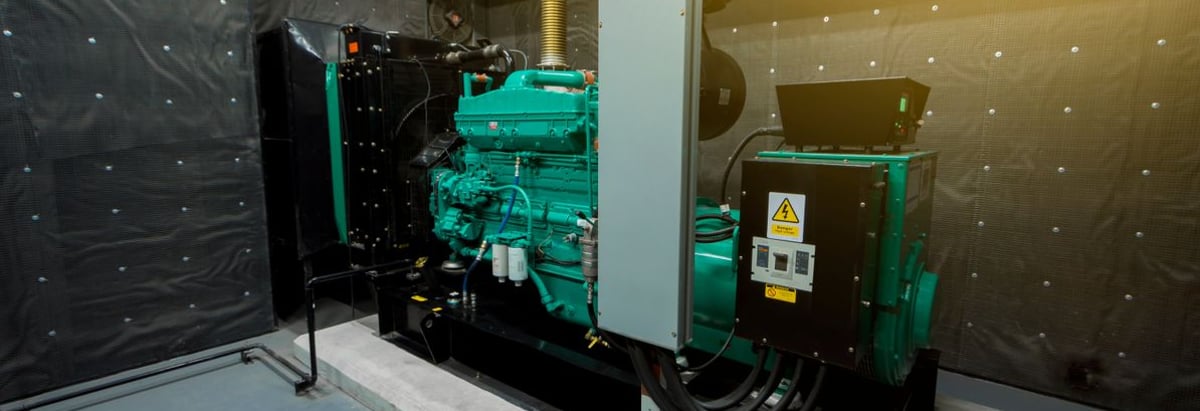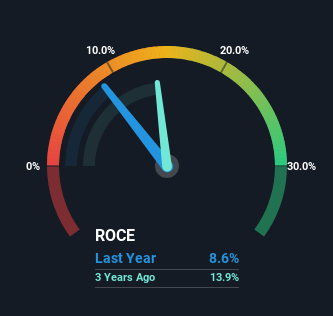- China
- /
- Electrical
- /
- SHSE:688698
Capital Allocation Trends At Suzhou Veichi Electric (SHSE:688698) Aren't Ideal

If we want to find a potential multi-bagger, often there are underlying trends that can provide clues. Firstly, we'll want to see a proven return on capital employed (ROCE) that is increasing, and secondly, an expanding base of capital employed. Ultimately, this demonstrates that it's a business that is reinvesting profits at increasing rates of return. Although, when we looked at Suzhou Veichi Electric (SHSE:688698), it didn't seem to tick all of these boxes.
What Is Return On Capital Employed (ROCE)?
Just to clarify if you're unsure, ROCE is a metric for evaluating how much pre-tax income (in percentage terms) a company earns on the capital invested in its business. To calculate this metric for Suzhou Veichi Electric, this is the formula:
Return on Capital Employed = Earnings Before Interest and Tax (EBIT) ÷ (Total Assets - Current Liabilities)
0.086 = CN¥176m ÷ (CN¥2.7b - CN¥688m) (Based on the trailing twelve months to March 2024).
Therefore, Suzhou Veichi Electric has an ROCE of 8.6%. In absolute terms, that's a low return, but it's much better than the Electrical industry average of 6.3%.
See our latest analysis for Suzhou Veichi Electric

In the above chart we have measured Suzhou Veichi Electric's prior ROCE against its prior performance, but the future is arguably more important. If you'd like to see what analysts are forecasting going forward, you should check out our free analyst report for Suzhou Veichi Electric .
So How Is Suzhou Veichi Electric's ROCE Trending?
The trend of ROCE doesn't look fantastic because it's fallen from 20% five years ago, while the business's capital employed increased by 718%. However, some of the increase in capital employed could be attributed to the recent capital raising that's been completed prior to their latest reporting period, so keep that in mind when looking at the ROCE decrease. Suzhou Veichi Electric probably hasn't received a full year of earnings yet from the new funds it raised, so these figures should be taken with a grain of salt.
On a related note, Suzhou Veichi Electric has decreased its current liabilities to 25% of total assets. So we could link some of this to the decrease in ROCE. What's more, this can reduce some aspects of risk to the business because now the company's suppliers or short-term creditors are funding less of its operations. Some would claim this reduces the business' efficiency at generating ROCE since it is now funding more of the operations with its own money.
What We Can Learn From Suzhou Veichi Electric's ROCE
While returns have fallen for Suzhou Veichi Electric in recent times, we're encouraged to see that sales are growing and that the business is reinvesting in its operations. However, despite the promising trends, the stock has fallen 10% over the last three years, so there might be an opportunity here for astute investors. As a result, we'd recommend researching this stock further to uncover what other fundamentals of the business can show us.
Suzhou Veichi Electric does come with some risks though, we found 3 warning signs in our investment analysis, and 1 of those is potentially serious...
If you want to search for solid companies with great earnings, check out this free list of companies with good balance sheets and impressive returns on equity.
New: Manage All Your Stock Portfolios in One Place
We've created the ultimate portfolio companion for stock investors, and it's free.
• Connect an unlimited number of Portfolios and see your total in one currency
• Be alerted to new Warning Signs or Risks via email or mobile
• Track the Fair Value of your stocks
Have feedback on this article? Concerned about the content? Get in touch with us directly. Alternatively, email editorial-team (at) simplywallst.com.
This article by Simply Wall St is general in nature. We provide commentary based on historical data and analyst forecasts only using an unbiased methodology and our articles are not intended to be financial advice. It does not constitute a recommendation to buy or sell any stock, and does not take account of your objectives, or your financial situation. We aim to bring you long-term focused analysis driven by fundamental data. Note that our analysis may not factor in the latest price-sensitive company announcements or qualitative material. Simply Wall St has no position in any stocks mentioned.
About SHSE:688698
Suzhou Veichi Electric
Engages in the development, manufacture, and marketing of industrial automation control products and system solutions in China and internationally.
Flawless balance sheet with high growth potential.

